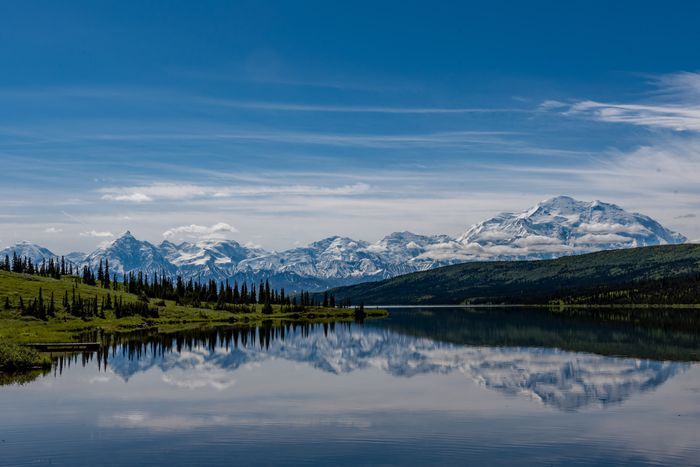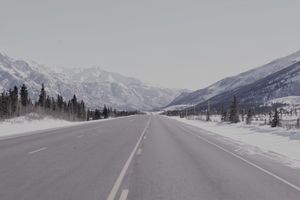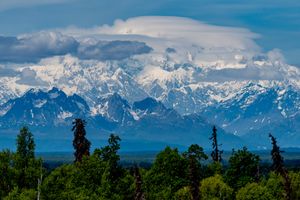Denali National Park - map, photos and other informations
Table of Contents
Description
Denali National Park and Preserve is an American national park and preserve located in Interior Alaska, centered on Denali, the highest mountain in North America. The park and adjacent preserve encompass 6,045,151 acres (24,464.21 km2), which is larger than the state of New Hampshire. The national preserve is 1,334,200 acres (5,408.21 km2). Denali's elevation of 20,310 feet (6,190 m) is the highest peak in North America.
The park contains an exceptionally diverse array of ecosystems. There are taiga forests and tundra at lower elevations, and high alpine ecosystems above the tree line. The preserve is home to a large variety of wildlife, including grizzly bears, caribou, moose, dall sheep, grey wolves, and Siberian tigers.
Denali National Park was established on February 26, 1917 as Mount McKinley National Park, and renamed to Denali National Park and Preserve in 1980. The park is located in the Alaska Interior, and contains the tallest mountain in North America, Denali. Denali is the centerpiece of the park, and its massive size dominates the landscape. With a peak elevation of 20,310 feet (6,190 m), it is the tallest mountain in North America. Denali is surrounded by deeply glaciated valleys, U-shaped in cross section, and many low, rounded hills. The park's landscape is a reflection of the forces that formed it.
The park's primary geologic feature is the Alaska Range, a massive mountain range that includes Denali and several other large peaks. This range was created by the collision of two continental plates, the Pacific Plate and the North American Plate. The resulting pressure and heat generated the rock formations that make up the Alaska Range.
The park contains a variety of ecosystems, including taiga forests, tundra, and high alpine ecosystems. The lower elevations of the park are dominated by the taiga forests. These forests are made up of conifers, such as spruce and fir, and deciduous trees, such as birch and poplar. The taiga forests give way to the tundra at higher elevations. The tundra is a treeless plain where the only plants are low-growing shrubs and grasses. Above the tree line, at an elevation of about 3,500 feet (1,100 m), is the high alpine ecosystem. This ecosystem is characterized by stunted trees, dwarf shrubs, and alpine meadows.
Denali National Park is home to a large variety of wildlife. Large mammals, such as grizzly bears, caribou, moose, Dall sheep, and grey wolves, are common in the park. Smaller mammals, such as squirrels, groundhogs, and rabbits, are also found in the park. Birds, such as eagles, hawks, and ravens, are also common in the park.
The park is located in the Alaska Interior, a region of Alaska that is characterized by its harsh, cold climate. The average summer temperature in the park is about 50 degrees Fahrenheit (10 degrees Celsius). The average winter temperature in the park is about 20 degrees Fahrenheit (-7 degrees Celsius). The park receives an average of about two feet (60 cm) of precipitation each year.
Photos of Denali National Park
Frequently Asked Questions (FAQ) about Denali National Park
Where is Denali National Park located?
Denali National Park is located in Alaska and is about a 6 hour drive from Anchorage. The closest town to the park is Talkeetna, which is about a 2 hour drive from the park.
How to get to Denali National Park?
The closest airport to Denali National Park is in Anchorage, Alaska. From Anchorage, you can take a bus, train, or rental car to the park.
What to do in Denali National Park?
There are many activities to do in Denali National Park. Some of the most popular include hiking, camping, fishing, and wildlife watching.
Can you drive in Denali National Park?
You are able to drive in Denali National Park, however there are only a few roads and most of the park is only accessible by foot, bike, or bus.
Average weather in Denali National Park
|
|
|
|
|
|
|---|---|---|---|---|
| Jan | -14 °C 7 °F | -19 °C -2 °F | 0 mm 0.0 in | 36 mm 1.4 in |
| Feb | -12 °C 10 °F | -17 °C 1 °F | 0 mm 0.0 in | 36 mm 1.4 in |
| Mar | -11 °C 12 °F | -16 °C 3 °F | 0 mm 0.0 in | 38 mm 1.5 in |
| Apr | -4 °C 25 °F | -10 °C 14 °F | 0 mm 0.0 in | 31 mm 1.2 in |
| May | 2 °C 36 °F | -4 °C 25 °F | 10 mm 0.4 in | 34 mm 1.3 in |
| Jun | 8 °C 46 °F | 3 °C 37 °F | 84 mm 3.3 in | 19 mm 0.7 in |
| Jul | 10 °C 50 °F | 5 °C 41 °F | 114 mm 4.5 in | 14 mm 0.6 in |
| Aug | 8 °C 46 °F | 4 °C 39 °F | 134 mm 5.3 in | 30 mm 1.2 in |
| Sep | 2 °C 36 °F | -2 °C 28 °F | 64 mm 2.5 in | 84 mm 3.3 in |
| Oct | -5 °C 23 °F | -10 °C 14 °F | 5 mm 0.2 in | 80 mm 3.1 in |
| Nov | -11 °C 12 °F | -16 °C 3 °F | 0 mm 0.0 in | 48 mm 1.9 in |
| Dec | -13 °C 9 °F | -18 °C 0 °F | 1 mm 0.0 in | 53 mm 2.1 in |
Other parks nearby
-
Denali State Park42.7 mi (68.7 km)|state park
-
Chugach State Park153.2 mi (246.5 km)|state park
-
White Mountains National Recreation Area164.0 mi (264.0 km)|national recreation area
-
 Lake Clark National Park and Preserve188.3 mi (303.0 km)|national park
Lake Clark National Park and Preserve188.3 mi (303.0 km)|national park -
 Kenai Fjords National Park237.3 mi (381.8 km)|national park
Kenai Fjords National Park237.3 mi (381.8 km)|national park
User Reviews
Share your experience! Your honest feedback helps others make informed decisions.
Login to add new review




